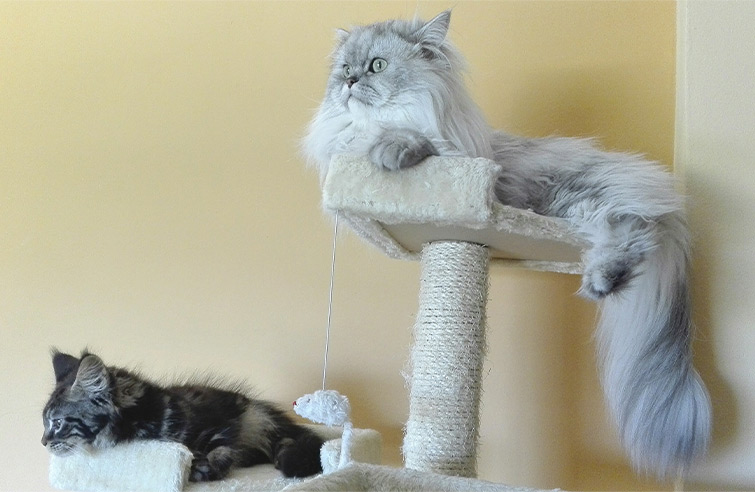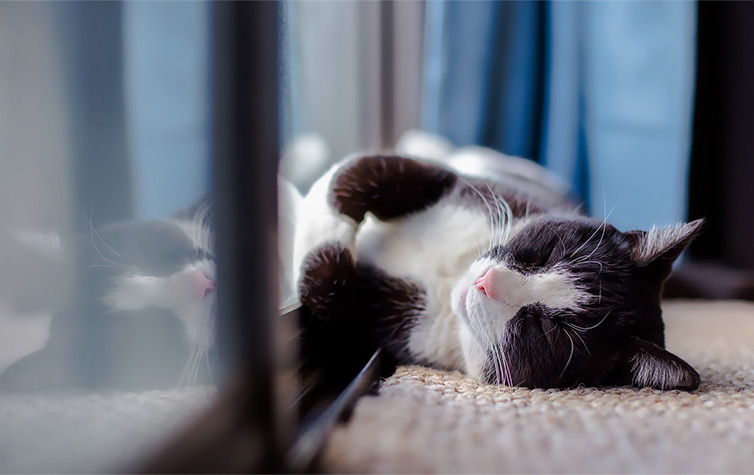Why Flea Treatments for Indoor Cats Are Necessary
Just because your feline friend doesn’t explore the great outdoors that often, doesn’t mean they are invincible to cat fleas. Read on to learn why your indoor cat still needs back-to-back flea treatments.
CATS

Posted by bravectosouthafrica – 19 June 2020
5 Places Indoor Cats Can Catch Fleas
Despite what you may think, indoor cats still run the risk of becoming flea-infested. Here are five of the most common places where they contract fleas.
#1 Sunbathing by an Open Window
Now, you may be thinking “I have insect screens, what’s there to worry about?” Well, fleas are so minute that not even an insect screen can stop them. The chances of your cat catching fleas significantly increase if:
- you have windows at a basement or ground level,
- there are bushes or tall grass nearby,
- or there’s a possibility of wild animals like rats, rabbits and mice roaming nearby, spreading flea eggs wherever they go.
Although fleas can’t fly, they can jump up to 33 cm across and 18 cm high. Mature cat fleas find a host via thermal and visual cues. Once within reach, they jump onto their victim and start consuming blood. Because of their size and tendency to stay close to the skin, they are notoriously difficult to spot.
#2 Chilling out on a Screened Porch
It’s the same problem as with the screened windows. Fleas can fit through even the tiniest of gaps. These blood-sucking beasties could be hiding out anywhere on your screened-in porch, simply waiting for their next victim to pass by. Although fleas tend to be found on four-legged creatures, they’ll settle for the two-legged variety as well. Fleas on humans will gravitate towards areas with thin skin, such as the ankles and wrists.
#3 Strolling Past an Open Door
Fleas are drawn to breathing, body heat and vibrations. So every time you open a door to the outside, they can sense both you and your pets and invite themselves in. Once indoors, they’ll locate a host and start feeding. If your cat isn’t protected, they will be at risk of becoming infested.
#4 Relaxing in or by Your Laundry Pile
You might just be the one to bring fleas into your home. Your muddy pants or dirty socks from yesterday evening’s jog could be harbouring some tiny fugitives. Because fleas resemble specks of dirt, your dirty laundry is their ideal camouflage. Furry friends looking to curl up for a cosy catnap are as good as infested.
#5 Hanging out With Other Animals
Do you have any other pets that are allowed outside? Or perhaps a friendly neighbourhood cat that occasionally pops in to say hello? Whether they live with or visit you, other animals can introduce fleas to your home. Once any visiting animals with fleas have entered your home or space, their parasitic problem becomes yours.

The Flea Life Cycle is Relentless
Mature female fleas will start laying up to 50 eggs 24 hours after feeding. All adult females go through this process and an animal is never infested with only one flea, meaning numerous adult fleas are feeding off and laying eggs on your precious furry baby.
At first, the eggs are sticky, but they soon dry out and roll off your pet, landing all around the house. These eggs then go through the entire 4-stage flea life cycle while hiding away in tiny nooks and crannies, multiplying with every new generation and becoming a bigger and more unbearable problem for everyone in the household. That’s why a creature as small as the flea causes such an enormous problem once inside your home.
Keep your indoor cat protected against unwanted intruders such as ticks, fleas and ear mites with Bravecto® Spot-On for Cats. The fast-acting and long-lasting formula will keep your cat free of ticks, fleas and ear mites for up to 3 whole months! Eradicate your current flea infestation – or prevent one – by treating your pets with a flea treatment that works: Bravecto®.

Subscribe to our Newsletter
Get to know your furry friend better! Sign up for all things dog- or cat-related.
The Hairy Facts about the dreaded hairball
12 April 2021
Help! My dog’s barking mad! Volume 2
12 April 2021
Your Itchy, Scratchy Cat – All About Cat Skin Problems
12 April 2021
The Dog’s Diet: A Bone of contention?
01 April 2021
Mango Fly Worms: How to Spot and Eliminate them
Posted on November 28,2019
Managing Mange And Mites In Your Dog
Posted on June 11,2018
Why Do Cats Purr and How? Learn What Your Cat Is Saying
Posted on October 14,2020
How to Get Rid of Ear Mites in Dogs
Posted on November 06,2019









